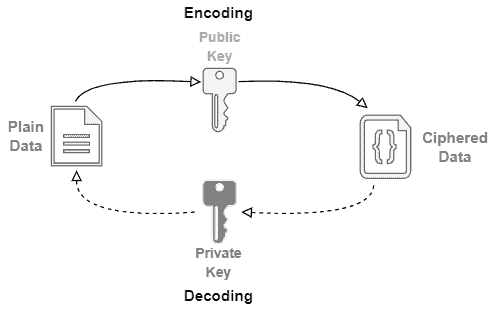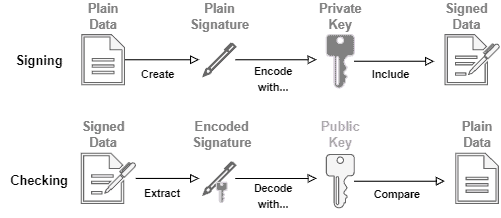1. 简介
加密技术在计算机世界中用途广泛,其中最常见的是保障数据的机密性(confidentiality)。例如,我们可以通过加密协议对文件或网络通信进行加密保护。但除此之外,加密还可以用于验证数据的来源,即真实性(authenticity)。
非对称加密(Asymmetric Encryption)不仅可以用于加密数据,也可以用于数字签名(Digital Signature),从而确保数据的完整性和来源可信。虽然两者都使用公钥和私钥这对密钥资源,但使用方式却大相径庭。
✅ 本文目标:
我们将深入探讨非对称加密中加密与签名的区别与实现机制,帮助开发者在实际开发中正确使用这两种技术。
2. 加密技术概述
加密的核心目标是保障数据的机密性,即把原始数据(明文)转换为他人无法直接理解的形式(密文)。
加密技术主要分为两大类:
对称加密(Symmetric Encryption)
使用同一个密钥进行加密和解密。优点是速度快,适合加密大量数据。常见算法有 AES、DES、3DES、ChaCha20 等。非对称加密(Asymmetric Encryption)
使用一对密钥(公钥和私钥)进行加密和解密。一个密钥加密的数据,只能由另一个密钥解密。适合用于安全通信协商、数字签名等场景。常见算法包括 RSA、ECC(椭圆曲线加密)、DSA 等。
下图展示了对称加密的基本流程:

对称加密虽然效率高,但在密钥分发和管理上存在挑战。而非对称加密虽然性能较低,但其灵活性和安全性使其在现代安全体系中占据重要地位。
3. 使用非对称加密进行数据加密
非对称加密最常见的用途是保障数据的机密性。其核心机制是:使用公钥加密,私钥解密。
3.1 加密流程
- 发送方使用接收方的公钥对数据进行加密
- 只有接收方的私钥才能解密该数据
- 因此,即使数据被中间人截获,也无法解密
这种机制广泛应用于 TLS/SSL、加密邮件、API 安全通信等场景。
3.2 示例图解

3.3 实际应用示例
- TLS 协议:客户端使用服务器的公钥加密会话密钥,建立安全通道
- Sealing API:在联网设备上使用公钥加密敏感数据,只有离线设备上的私钥可以解密,防止数据泄露
4. 使用非对称加密进行数字签名
除了加密,非对称加密的另一个重要用途是数字签名,用于验证数据的真实性与完整性。
4.1 签名流程
- 签名者使用自己的私钥对数据的哈希值进行加密,生成签名
- 接收方使用签名者的公钥解密签名,得到原始哈希值
- 接收方对收到的数据重新计算哈希,并与签名中的哈希对比
- 若一致,则说明数据未被篡改,且来源可信
4.2 示例图解

4.3 签名的关键点
- 签名对象是数据的哈希值,而不是原始数据本身
- 签名过程是用私钥加密哈希值
- 验签过程是用公钥解密哈希值并与本地计算的哈希比对
4.4 示例代码(Java)
import java.security.*;
import java.util.Base64;
public class DigitalSignatureExample {
public static void main(String[] args) throws Exception {
// 生成密钥对
KeyPairGenerator kpg = KeyPairGenerator.getInstance("RSA");
kpg.initialize(2048);
KeyPair keyPair = kpg.generateKeyPair();
String data = "This is the data to be signed.";
byte[] dataBytes = data.getBytes();
// 创建签名
Signature signature = Signature.getInstance("SHA256withRSA");
signature.initSign(keyPair.getPrivate());
signature.update(dataBytes);
byte[] digitalSignature = signature.sign();
System.out.println("Signature: " + Base64.getEncoder().encodeToString(digitalSignature));
// 验签
signature.initVerify(keyPair.getPublic());
signature.update(dataBytes);
boolean isVerified = signature.verify(digitalSignature);
System.out.println("Signature verified: " + isVerified);
}
}
输出结果:
Signature: [Base64 编码的签名值]
Signature verified: true
⚠️ 注意: 签名的目标是数据的哈希,而不是数据本身。因此,即使数据本身被公开传输,只要签名验证通过,就能确保数据来源可信且未被篡改。
5. 系统性总结
下表总结了非对称加密中加密与签名的主要区别:
| 特性 | 加密(Encoding) | 签名(Signing) |
|---|---|---|
| 加密目标 | 整个数据 | 数据的哈希值 |
| 使用的加密密钥 | 接收方的公钥 | 发送方的私钥 |
| 使用的解密密钥 | 接收方的私钥 | 发送方的公钥 |
| 主要目标 | 机密性(Confidentiality) | 真实性(Authenticity) 完整性(Integrity) |
6. 总结
本文系统讲解了非对称加密在加密数据和数字签名中的使用方式。
- 加密用于保障数据的机密性,使用公钥加密、私钥解密
- 签名用于验证数据的真实性和完整性,使用私钥签名、公钥验签
- 两者都依赖于公钥和私钥这一对密钥资源,但使用方式完全不同
在现代软件开发中,尤其在 API 安全、身份认证、电子合同、区块链等场景中,非对称加密技术扮演着至关重要的角色。
✅ 建议:
- 加密时使用接收方的公钥
- 签名时使用自己的私钥
- 验签时使用对方的公钥
- 保护好私钥,避免泄露
掌握这些核心概念,有助于我们在开发中避免常见的安全陷阱,写出更健壮、更安全的系统。